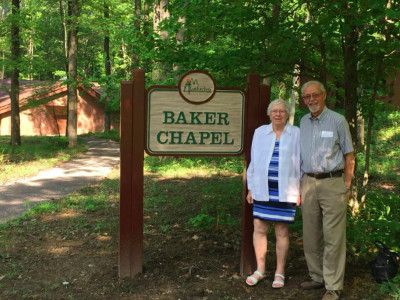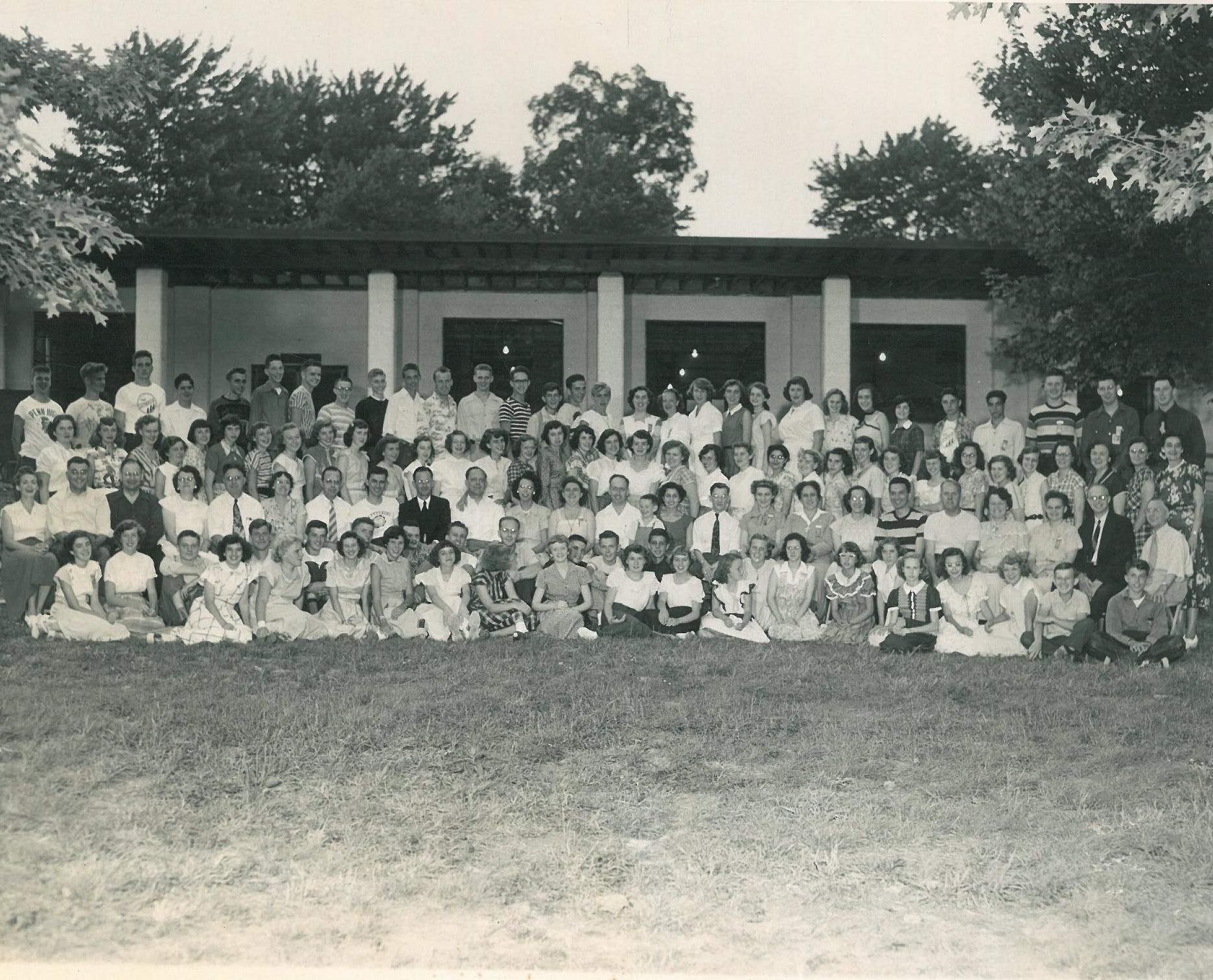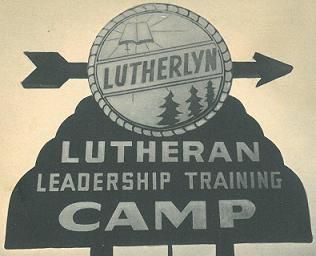
History of Lutherlyn
How It All Started
In 1941, Dr. H. Reed Shepfer, President of the Pittsburgh Synod of the United Lutheran Church, asked the Rev. Sam S. Shaulis if he and four young people could come visit Camp Woakhanna (Indian name meaning Crooked Creek). This camp had been established by Pastor Shaulis and the members of First Lutheran Church, Vandergrift, PA. Dr. Shepfer and the young people were impressed with Camp Woakhanna and began to pursue the idea of establishing a synod youth camp in western Pennsylvania.
At Synod Convention in 1943, a petition signed by 30 pastors of the Pittsburgh Synod of the United Lutheran Church, asked that a committee be established to explore the possibility of a “leadership training camp” be built somewhere in western Pennsylvania. The synod voted favorably on the petition. A committee was indeed formed and subsequently returned a report to the synod recommending the founding of such a camp.
At the 1944 Synod convention, Dr. Russell F. Steininger and Rev. Sam S. Shaulis presented a report from the committee. The Synod voted to authorize taking an option on a site.
On June 19, 1945, an organizational meeting was held at the synod chapel led by Dr. H. Reed Shepfer, president of the synod.
At this meeting the following officials were elected:
Dr. R. F. Steininger was elected president of the association and later Lutherlyn's first director.
Rev. S. S. Shaulis, Vice-President;
Rev. Paul E. Daugherty, Secretary;
Dr. Elmer F. Rice, Treasurer.
The committee, comprised of 17 members, were authorized to purchase the land and plan the building process. Two weeks after this meeting the committee inspected land located nine miles west of the city of Butler near Route 422.
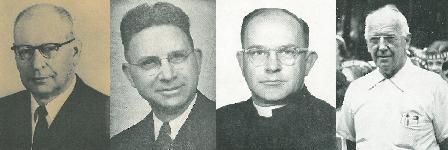
According to a publication of the Pittsburgh Synod, “The committee walked, crawled, and stumbled over the wooded area for four hours to view the entire property, then rested in the cool shade on the hillside to discuss the possibility of using this site for the proposed camp.”
The first land purchase consisted of 147 acres at a cost of $8,300. Further purchases of land increased to 365 acres for opening season in 1949. Of course, the land needed developing before it could be used for camping purposes. A road into the camp had to be built; water, gas, electricity and sewage systems had to be established.
These beginning costs were $47,000. By action of the Board of Directors of the Leadership Camp Corporation of the Pittsburgh Synod (U.L.C.A.) on September 5, 1945, the camp was officially named Lutherlyn. On October 1, 1945 the Department of State for the Commonwealth of Pennsylvania registered Lutherlyn as a nonprofit corporation. By action of the Board of Directors of Lutherlyn on March 12,1946, Dr. Steininger was named the first full-time director of Lutherlyn.
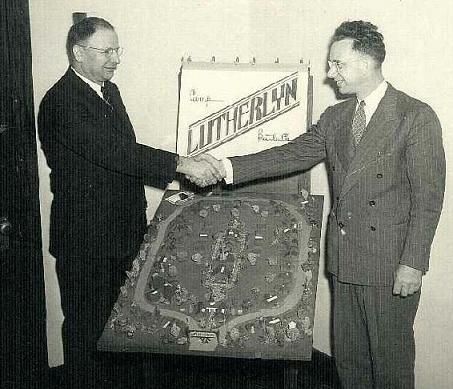
Dr. Steininger and Rev. Shaulis shown with a model that was taken to conference meetings to create interest in the camp project.
During 1946-48 much preparation commenced. A $250,000 fund drive was launched, directed by the Rev. Paul Daugherty. Dr. Steininger supervised the clearing of the grounds and the planning of the buildings.
Succeeding The Rev. Dr. Steininger, The Rev. Sam Shaulis was named part-time director on June 20, 1949, called by the Board as full-time Director on October 31, 1950 and installed on June 10, 1951.

Developing the Camp
The rugged area presented a beautiful sight, but it needed developing to make it into a real camp. A road was needed. An adequate water system had to be installed, as well as gas, electric, and sewage systems.
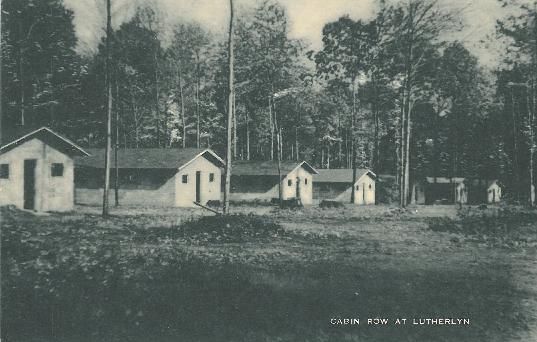
Hunker Hall
The Dining hall at Lutherlyn was named Hunker Hall on Lutherlyn Day, 1949 in consideration of a large and generous gift by Mr and Mrs G Fred Hunker. Hunker hall was thus named in loving memory of Mr Hunker's parents, Mr and Mrs Leonard Hunker.
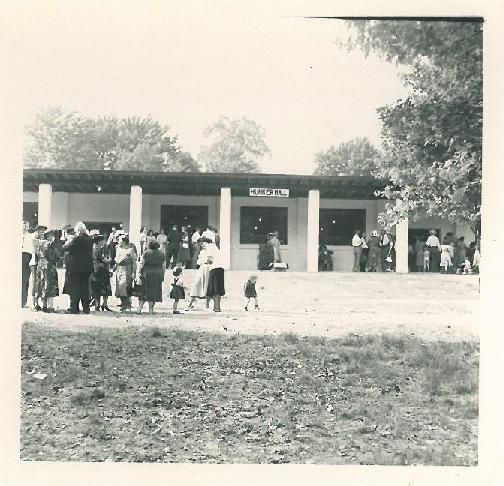
Rice Memorial Hall
Named on Lutherlyn Day of 1951 in consideration of a large and generous gift by the Rev. Elmer F. Rice D.D. and because of the long and faithful service rendered by Dr. and Mrs. Rice to Lutherlyn. This gift by Dr. Rice was in loving memory of his wife, Amy Magdalene Rice.
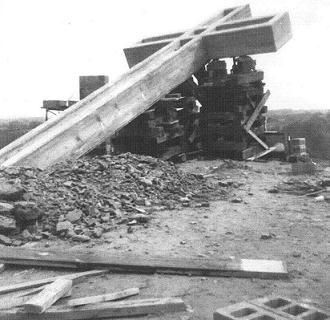
Chapel Hill
Chapel Hill, sponsored by St. Paul’s Lutheran Church in Monessen, Pa, was dedicated June 8, 1952. The cross is made of concrete and weighs over 40 tons. It stands 30 feet above ground and is cemented in solid sandstone 11 feet below the ground. The nine cement block pillars memorialize nine young men from their congregation who died in World War II, and represent nine different nationalities.
In 1952, the first wedding was held at Lutherlyn. Dorothy Shaulis, daughter of the Executive Director, married Robert Sternet.
For the first time, during the 1954 season, camp was able to make adequate use of the worship facilities on Chapel Hill. Seats were installed so that campers and staff could better use this lofty sanctuary with its large cross, altar, and pylons.


Upper Lake
In 1953, the Upper Lake was constructed to act as a reserve body of water to feed the lower lake in dry weather. The 1954 season was the first season to have this added facility available.
The Education Building
On August 3, 1954 ground was broken for the education building. With the completion of this building, Lutherlyn finally had all the buildings necessary for its current program need. The education building was designed with eight classrooms, a large assembly room, and a porch running the entire width of the building.
Junior Camp (later known as Camp Shaulis in 1967)
On September 20, 1957 the Lutherlyn board voted to build ten new camper cabins and an associate director's cabin at the eastern extremity of the present camp cabins. These ten cabins, holding up to 120 campers, served as the Junior Camp running simultaneously with the regular camp accommodating about 200. Both camps were set up to use the same craft equipment, dining facilities (though at different times). The junior camp had its own programming and own associate director. A cabin was named after a congregation or individual for a donation of $1500.
The dedication service for the Junior Camp was held June 8th, 1958.

Programming
During the summer of 1948 Lutherlyn operated as a series of day camps with vespers services conducted each Sunday afternoon at 4:30 from June 15 through August. From August 9-13 programming was conducted from 11:30 AM until 8:00 PM.
Lutherlyn began full residential operation in 1949. The official dedication was held on Sunday, June 12 at 4 PM. The June 13, 1949, edition of the Butler Eagle described the day. “Automobiles were lined bumper to bumper on the road to Lutherlyn yesterday afternoon, as an estimated crowd of over 4,000 persons flocked to the formal dedication ceremonies of the camp. The Dr. George Berkheimer, Director of Camp Nawaka, gave the dedication address. The facility opened with 16 camper cabins, six faculty cabins, and administration building, a craft house, and a kitchen and dining hall, which also served as classrooms and general meeting place. Also, lower lake was completed. The dining hall could accommodate 300 campers in addition to the staff. The camp opened June 26, 1949, with a two-week camping period for senior girls. Other camping groups would be accommodated for two-week periods through August 21.
The first camping season at Lutherlyn in 1949 brought 426 campers. By 1955, there were 1621 campers, which was near full capacity. Initially, Lutherlyn was deemed a Leadership Training Camp.
The first summer conducted 7 programs (2 two-week sessions and 5 one-week sessions). Camp started each week on Sunday afternoon and ended the next Sunday at noon with a meal after a closing worship service that morning. It was encouraged that the campers arriving for the week were not to arrive early and interrupt the closing worship.
The first summer cost $16.00 for one-week campers and $32.00 for the two-week programs. Campers were also encouraged to bring an additional $2.00 for purchase of instructional materials and small items at the camp store. There were a total of 435 campers the first summer plus several retreat groups.
In 1950 Walter F. Shively initiated Lutherlyn's first nature program.
From 1949 to 1957 the original cabins were filled to capacity and required 300 volunteer counselors each year. In 1958 there were a total of 2,700 summer campers.
1960s
Changing Approaches and Attitudes
By 1959 Lutherlyn had become one of the largest camps in the Lutheran Church with accommodations for over 400 campers and staff. An exciting program of conference camping for children and youth from grades four through twelve was conducted on site during the ten week summer season. By the end of the decade heaters were also installed in all buildings to meet the increasing popularity of retreat options during the spring and fall, particularly on weekends.
During the 1960's the basic approach and philosophy of camping ministry in the LCA (and other church bodies) responded to a change that was sweeping the country. Teaching techniques were changing from the large classroom setting, to smaller less formal groups where interpersonal relationships had greater opportunity to develop. The "Sunday School in the woods" philosophy gave way to a new emphasis on human relations and a type of caring and sharing that was not possible in a highly structured program.
There was also a developing new attitude toward God's creation and the natural world. Attention shifted from a knowledge of nature, to a concern for the environment and to God's purpose for creating our Earth as He did. In an effort to adapt the ministry of camping to a changing society where the interests of young people are so diversified, it was deemed necessary to provide a variety of programs with special interests that appealed to as many campers as possible.

Campers Admire the Ocelot While the Ocelot Admires the Rabbit
Developments
In 1960 the Health Hut was built near the parking lot, in 1961 a maintenance building was built, and in 1962 Wallace Hall, a meeting and recreation building was built in Camp Shaulis.
In 1963 ground was broken for an additional dining room to be built on the side of Hunker Hall which was used for the first time in 1964.
Leadership Changes
The Rev. Sam S. Shaulis retired in 1962. The Rev. Dr. Don Anderson became the Director of Camping, splitting his time between the synod office and the camp. In 1967 the barn property was purchased. In the late 1960s the camp grew to 543 acres. Six Conestoga wagons were constructed in 1965-66 and placed near upper lake. They were used in the camping program for many years.
Mr. Edward Miller was appointed Executive Director in 1966.
In 1968 a week of camp cost $30 and still operated with volunteer staff.

Programming
In 1965, Lutherlyn conducted its first Outpost summer programming. A decision was made by Lutherlyn's Board and the Synodical Committee on camping to collaborate on an experiment in outpost camping. The result was the establishment of Trinity Pines. Four tents, a dining fly, toilets, and other necessary facilities were located at the site of the old cottage at the southern end of the camp property approximately one half mile from Chapel Rock. Those who have visited this spot will remember the three beautiful, huge evergreen trees. This the camp was appropriately named "Trinity Pines."

Eating in Hunker Hall, the barn (acquired 1967), Brotherhood Lake swimming, Chapel Rock, Trinity Pines Outpost Camp, Conestoga Wagon on Upper Lake
1970s
A Family Campgrounds were dedicated in 1971 with a new shower facility and three family-size cabins along with 21 electric sites for campers and tents.
Programming was becoming more diversified allowing for more specialty programs. In 1971 a model rocketry program started by Unit Leader, Dick Freed. The program has been offered every year since making 40 years in 2011.

1974 summer camp options included Outpost, Canoeing, Horseback Riding, Sports-a-Field, Bicycle Camp, White Water Rafting, Trail Camp, Baton Twirling, Model Rocketry, Confirmation Camp, Family Camp, Canadian, and Upper Delaware Canoe Trip.
In 1975 the first programmed bus trip to the West began. This program consisted of 13 days costing $250.00 with destinations to the Grand Canyon, Rocky Mountains, Black Hills, Mt. Rushmore, and the Bad Lands.
The 1970s also saw the transition to paid summer staff. The on-site horse program was implemented in the late 1970s.
Lutherlyn observed its 25th anniversary on October 14, 1973 with an open house. An estimated 1,000 persons visited the camp during this weekend. Among those in attendance were four members of the original board of directors and three campers from the first camping season.
By the end of the decade, many meeting halls and 14 cabins were winterized enabling Lutherlyn to be utilized throughout the entire year and the introduction of winter retreats.

1980s
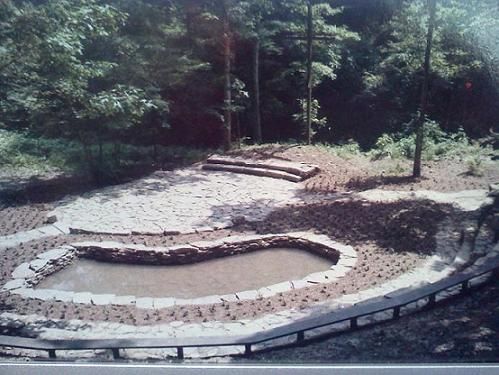
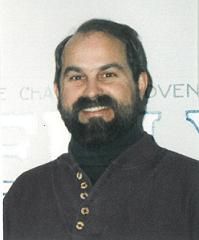
Construction of the Steininger Memorial Amphitheater began in 1977 and it was dedicated July 13, 1980.
In 1982, Lutherlyn conducted its first ever capital funds campaign. Money raised from this campaign made possible the entrance road to be repaved; nearly every building was re-roofed; 8,000 feet of new gas line was laid; new shower houses were built; the maintenance building was enlarged and the debt to the synod was paid off.
In 1984, Ed Miller stepped down as Executive Director and became the Development Director. In 1985, The Rev. Randal Gullickson was called as Executive Director.
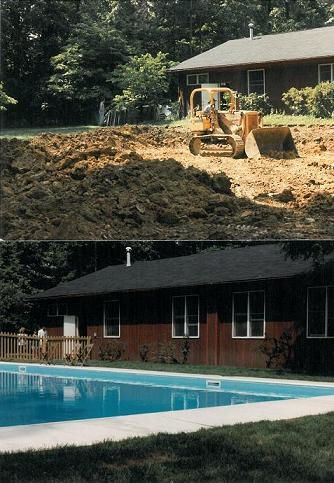
In 1986 the swimming pool and the ropes challenge course were built.
In 1987 the old Director’s Cabin became the Ark Guest House, the Stewart Retreat Center was remodeled, and the Trinity Pines Club was started with 47 charter members. The “Cabin Village Plan” was begun in 1987 to replace the crumbling, summer only, block cabins of the main camp after 40 years of service with winterized, high-comfort cabins. Yellow Pine, the first of these cabins, was built by First English in Butler in 1987-88.
In 1988, the 40th Anniversary was observed with a day-long celebration.
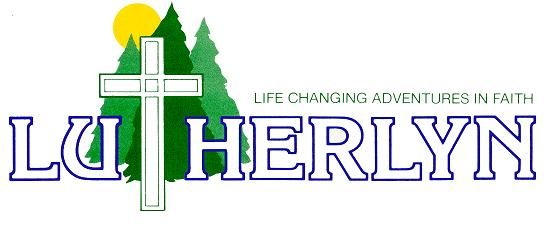
A new slogan “Life Changing Adventures in Faith” was officially adopted in 1989. The “Camp On The Road” Day Camp program that brings camp to the congregations began. The Eberly Environmental Education Center (nature center) was constructed and dedicated on Oct. 15, 1989. The Lutherlyn Environmental Education Program (LEEP) was established by Miriam Youngquist-Thurow and began serving schools all over western PA. The Forest Village A-Frames were completed and the Shively Health Hut was remodeled.
Ed Miller retired after serving 30 years at Lutherlyn. He first served as Business Manager, then Camp Director, Executive Director and, finally, as Director of Development.
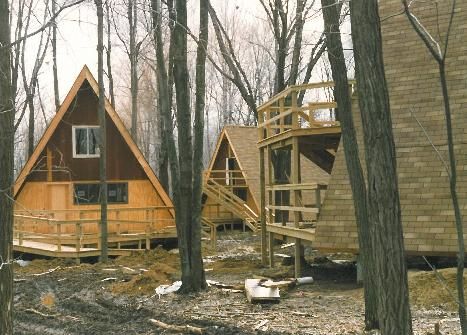
1990s
In 1992 the horse barn was refurbished and an award-winning rotational pasture system was established. In July, the first annual “SummerFest” was held.
In 1993, participation in the LEEP program neared 3,000. The “Keeping the Promise Appeal” was launched in 1994 to fund the construction of a water treatment plant, a sewage treatment plant and a new winterized dining hall. 228 Lutheran congregations participated in that appeal. LEEP began offering its Maple Syrup Education Program. More log cabins were also completed that year.
In 1995, The Terra Dei (God’s Earth) Homestead was built as a demonstration site for low-impact, green living. Construction was completed in 1996. Todd and Shayne Garcia-Bish were its first residents.
Ground was broken for the new dining hall on October 5, 1997. Also in that year, Dale and Jeane Smart built the first of the Ridge cabins and, with the Forest Village A-frames and the Log Village complete, the lower shower house was gutted and remodeled into Redwood Lodge, a beautiful meeting center.
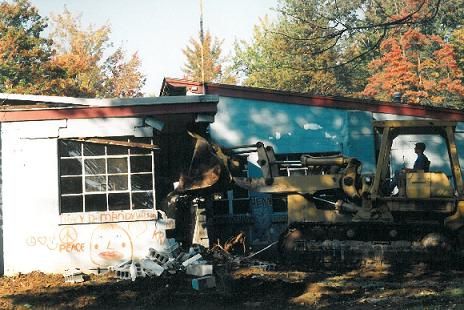
1998 – Lutherlyn was 50!! Former Executive Director, Ed Miller, presented the history of Lutherlyn at this Anniversary Celebration. “Lutherlyn has remained faithful to its mission of providing Christian leadership development for people of all ages through its life-changing adventures in faith.”
The water treatment system and the waste water disposal system were completed in 1998.
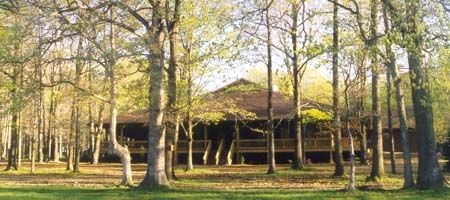
A series of troublesome contractors delayed the completion of the dining hall. In a summer-saving act of generosity, some people who love Lutherlyn deeply funded Dogwood Pavilion, our huge picnic shelter, and made 1998 the “Summer of the Perpetual Picnic” as Wallace Hall was pressed into service as a kitchen and all meals were served in Dogwood. The dining hall was dedicated in 1999. The Trinity Pines Club reached 500 members.
With the new dining hall on line, 14 cabins in the replacement project completed, Redwood Lodge set up for meeting, and the Eberly Environmental Education Building, Lutherlyn had attained the capability to serve people in comfort year round.
2000s
In 2000, Terra Dei Homestead was dedicated. The site has been in use since 1994 and a residence since 1996. The dedication celebrated the realization of the original dream for Terra Dei Homestead. Wallace Hall was renovated following its use as a full kitchen.
In 2002 new lighting was installed in the Steininger Memorial Amphitheater replacing the always volatile candle luminaries.

Construction of the last village of cabins Arbor Village) in the main camp was underway in 2003 after completion of the Ridge Village. A new pitched roof was installed on both Derr Hall (education building) and Rice Hall thus beginning the end of the nightmare of rubber roofing in a forest. The Abandoned Mine Drainage Mitigation project to clean up our stream and the wind energy project at Terra Dei began in 2003.
2004 saw the Pottery Shop up and running and also a new path lighting from the parking lot to the dining hall.
A State Energy Harvest Grant was obtained in 2005 to install a wind turbine on Chapel Hill to power Terra Dei with clean wind energy. Also, in 2005 a sand beach is put in at the lake – reclaiming an asset of the 1940s.
Trinity Pines Club celebrated its 20th anniversary in 2006.
Barry Nelson, Site Manager at Lutherlyn, retired after 32 years of service in the maintenance of everything and having a role in the building of everything new or remodeled since 1976.
The main camp cabin replacement project is completed in 2006 – 20 cabins in 18 years! The cabins were designed in four half-circle villages (Arbor, A-Frame, Logs, and Ridge).
Rev. Randy Gullickson retired as the Executive Director of Lutherlyn on August 6, 2016.
Rev. Don Hayn served as the interim Executive Director from October of 2016-October of 2017.
Deacon Debra Roberts was called to serve as the Executive Director on October 1, 2017. Deb was a summer camper from 1989-1993, summer staff from 1994-2001, the Office Manager from 2002-2005, and the Associate Director from 2005-2017.
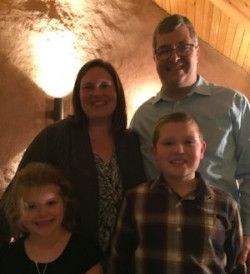
After 10 years of construction, Baker Chapel was dedicated on May 28, 2018.
